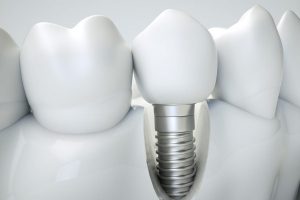I had a great experience, the staff are super nice and very informative. They made sure i was fine and asked if i had any questions, the surgery itself went perfectly smooth. I would recommend them to anyone needing oral surgery. Definitely had a positive experience.
General Information
 Dental implants are a great way to replace missing teeth and also provide a fixed solution to removable partial or complete dentures. They are designed to provide a replacement for teeth which look, feel and function like natural teeth. Implants help preserve facial bone and prevent bone deterioration which occurs when teeth are lost.
Dental implants are a great way to replace missing teeth and also provide a fixed solution to removable partial or complete dentures. They are designed to provide a replacement for teeth which look, feel and function like natural teeth. Implants help preserve facial bone and prevent bone deterioration which occurs when teeth are lost.
Reasons for Dental Implants
- Replace one or more missing teeth without affecting adjacent teeth
- Resolve bite problems caused by teeth shifting into missing tooth spaces
- Restore a patient’s confidence to smile
- Restore chewing efficiency
- Restore facial tissues support
- Support a partial or complete denture, making them more secure and comfortable
What is an Implant?
A dental implant is a titanium screw that is surgically placed into the upper or lower jaw bone. The metal screw substitutes the missing tooth root. The bone bonds with the titanium, creating a strong foundation needed for an artificial tooth. Small posts (healing abutments) are then attached to the implants. The healing abutments protrude through the gum tissues. These posts provide a stable anchors for the prosthesis (i.e. a crown, a partial denture or a complete denture).
The Surgical Procedure
The process of getting implants requires a number of visits over several months. This type of procedure can be performed with a local anaesthetic. Sedation and general anaesthesia are also an option. This will be discussed with you at your initial consult. For most patients, the placement of dental implants involve a few phases.
Phase 1
In order to have the implant placed, the surgeon will evaluate whether enough bone is present for the implant to be placed. This generally can be seen using a cone beam tomography (CBCT); a high resolution radiograph. (see Bone Grafting) If there is not enough bone present, your surgeon may have to perform an additional procedure in which he will add bone to the area prior to implant placement (see Bone Grafts). If enough bone is present, the implant will be placed into the jawbone. For the first 3-4 months following surgery, the implant integrates (fuses) with the jawbone. Although you should be able to wear your temporary prosthesis or denture (if applicable), during the healing time, your doctor may advise you not to wear it for a few days following the procedure.
Phase 2
Once the implant has integrated to the jawbone, the second phase can begin. This phase is when the implant is uncovered. Generally performed under a local anesthetic, your doctor will uncover the implant and attach a small post (healing abutment), which acts as an anchor for the prosthesis (i.e. crown, bridge or denture). These posts protrude through the gum tissue. After a healing period, your dentist fits the artificial tooth (crown or bridge) to the post. The post will not be seen as the tooth will cover it.
Types of Prostheses
An implant retained crown is used to replace a single missing tooth. An implant retained bridge can replace two or more teeth and requires two or more implants. A complete implant retained dental prosthesis replaces all the teeth in your upper or lower jaw. The number of implants varies depending upon which type of complete prosthesis is recommended. A removable complete prosthesis (overdenture) is also an option for the lower jaw. It attaches to a bar or ball attachments. It can be removed by the patient for cleaning.
Dental implants are very strong, stable, and durable. They will last for many years. On occasion, the prosthesis may have to be re-tightened due to normal wear. You will receive care instructions when your treatment is completed. Good oral hygiene and regular dental visits are required to maintain and care for your implants.
